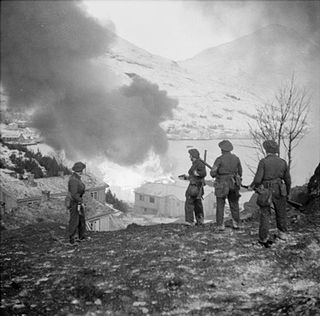 W
WAn ambush is a long-established military tactic in which combatants take advantage of concealment and the element of surprise to attack unsuspecting enemy combatants from concealed positions, such as among dense underbrush or behind hilltops. Ambushes have been used consistently throughout history, from ancient to modern warfare. In the 20th century, an ambush might involve thousands of soldiers on a large scale, such as over a choke point such as a mountain pass, or a small irregular band or insurgent group attacking a regular armed force patrol. Theoretically, a single well-armed and concealed soldier could ambush other troops in a surprise attack. Sometimes an ambush can involve the exclusive or combined use of improvised explosive devices, that allow the attackers to hit enemy convoys or patrols while minimizing the risk of being exposed to return fire.
 W
WA battle is a combat in warfare between two or more armed forces. A war usually consists of multiple battles. In general, a battle is a military engagement that is well defined in duration, area, and force commitment. An engagement with only limited commitment between the forces and without decisive results is sometimes called a skirmish.
 W
WA blockade is an effort to cut off supplies, war material or communications from a particular area by force, either in part or totally. A blockade is not an embargo or sanctions, which are legal barriers to trade. It is also distinct from a siege in that a blockade is usually directed at an entire country or region, rather than a fortress or city. While most blockades historically took place at sea, blockade is still used on land to prevent someone entering a place.
 W
WCivil-military operations or CMO are activities of a military force to minimize civil interference on and maximize civil support for military operations. CMO is conducted in conjunction with combat operations during wartime and becomes a central part of a military campaign in counter-insurgencies. Some militaries have specialized units dedicated to conduct CMO, such as civil affairs forces or form task forces specifically for this purposes, such as a joint civil-military operations task force in the U.S. Military. Also, some militaries have staff sections dedicated to planning and coordinating CMO for their command. CMO is often called civil-military co-operation or CIMIC in NATO operations and civil-military co-ordination in UN operations.
 W
WCombat is a purposeful violent conflict meant to weaken, establish dominance over, or kill the opposition, or to drive the opposition away from a location where it is not wanted or needed.
 W
WMilitary deception (MILDEC) refers to attempts by a military unit to gain an advantage during warfare by misleading adversary decision makers into taking actions detrimental to the adversary. This is usually achieved by creating or amplifying an artificial fog of war via psychological operations, information warfare, visual deception, or other methods. As a form of disinformation, it overlaps with psychological warfare. Military deception is also closely connected to operations security (OPSEC) in that OPSEC attempts to conceal from the adversary critical information about an organization's capabilities, activities, limitations, and intentions, or provide a plausible alternate explanation for the details the adversary can observe, while deception reveals false information in an effort to mislead the adversary.
 W
WFriendly fire is an attack by a military force on friendly or neutral troops while attempting to attack the enemy. Examples include misidentifying the target as hostile, cross-fire while engaging an enemy, long range ranging errors or inaccuracy. Accidental fire not intended to attack the enemy, and deliberate firing on one's own troops for disciplinary reasons, is not called friendly fire, and neither is unintentional harm to civilians or structures, which is sometimes referred to as collateral damage. Training accidents and bloodless incidents also do not qualify as friendly fire in terms of casualty reporting.
 W
WA low-intensity conflict (LIC) is a military conflict, usually localised, between two or more state or non-state groups which is below the intensity of conventional war. It involves the state's use of military forces applied selectively and with restraint to enforce compliance with its policies or objectives.
 W
WA non-combatant evacuation operation (NEO) is an operation conducted to evacuate civilians from another country, generally due to a deteriorating security situation.
 W
WIn military/security studies and international relations, "police action" is a military action undertaken without a formal declaration of war. Today the term counter-insurgency is more used.
 W
WRaiding, also known as depredation, is a military tactic or operational warfare mission which has a specific purpose and is not normally intended to capture and hold a location but instead finish with the raiding force quickly retreating to a previous defended position prior to enemy forces being able to respond in a coordinated manner or formulate a counter-attack. A raiding group may consist of combatants specially trained in this tactic, such as commandos, or as a special mission assigned to any regular troops. Raids are often a standard tactic in irregular warfare, employed by warriors, guerrilla fighters or other irregular military forces. Some raids are large, for example the Sullivan Expedition.
 W
WIn the military of the United States, strikes and raids are a group of military operations that, alongside quite a number of others, come under the formal umbrella of military operations other than war (MOOTW). Ex-military authors Bonn and Baker describe them as "nothing more than the conduct of conventional combat missions on an individual or small-scale basis", and what they mean, specifically, depends on which particular branch of the military is using them. However, they do have formal, general, definitions in the United States Department of Defense's Joint Publication 1-02:strikeAn attack to damage or destroy an objective or a capability. raidAn operation to temporarily seize an area in order to secure information, confuse an adversary, capture personnel or equipment, or to destroy a capability culminating with a planned withdrawal.
 W
WA tactical withdrawal or retreating defensive action is a type of military operation, generally meaning that retreating forces draw back while maintaining contact with the enemy. A withdrawal may be undertaken as part of a general retreat, to consolidate forces, to occupy ground that is more easily defended, force the enemy to overextend to secure a decisive victory, or to lead the enemy into an ambush. It is considered a relatively risky operation, requiring discipline to keep from turning into a disorganized rout or at the very least doing severe damage to the military's morale.